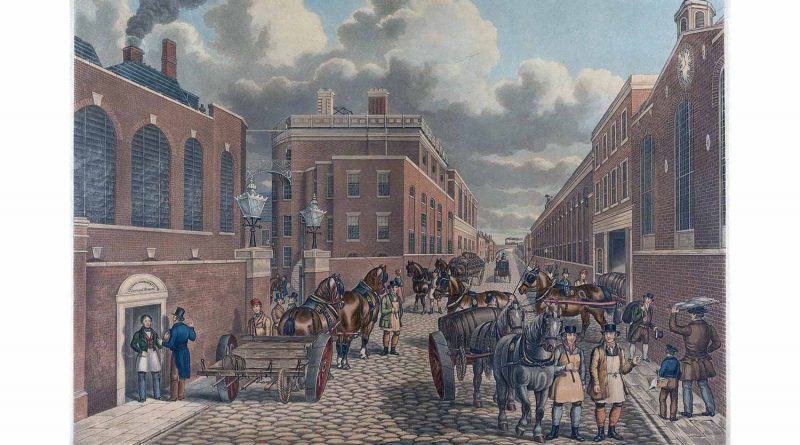The Truman Brewery: a history of the world’s largest brewery
It was once the world’s largest brewery played host to cabinet dinners and was at one stage, run by one of Britain’s most vociferous anti-slavery campaigners.
It is at the arches of the brewery that a largely white hipster population gives way to a predominantly working-class British Bengali demographic.
The shopfronts reflect this demographic change, Swedish delicatessens and expensive cafés turn to small family-run independent Indian restaurants and shops as you head toward the streets’ southern end.
Politically, the brewery also divides Brick Lane. It is on the site of the brewery, which presently houses hundreds of small businesses, that a towering glass and steel office and shopping complex is proposed.
At this crucial juncture in the brewing plant’s life, as we await the results of a judicial review that will determine the future character of the building, and of the area itself, it seems like the appropriate time to look at the history of the site, to see how we have reached this point.
Although the future of the brewery remains uncertain, the greatness of its past is clear as day.
It was once London’s largest brewery which produced a beer loved by royalty, the brewery supplied beer the world over, played host to cabinet dinners and was at one stage, run by one of Britain’s most vociferous anti-slavery campaigners.
Its history is tightly wrapped up in the DNA of the East End and in the DNA of England itself.
The origins of the Black Eagle Brewery site, and the Truman Brewing company which operated on it for over 300 years, are shrouded in myth.
It is generally accepted that the original site at 91 Brick Lane was erected by the Bucknall family in the 1660s and that when the brewery company ceased operating in 1989, it was one of London’s oldest brewing plants.
Throughout the brewery’s years in operation, many monumental figures stood at its helm.
Joseph Truman, one such figure, took control of the site in its infancy, and by the time of his death in 1719, he had laid the solid foundations of a business which was to become the capital city’s largest brewery.
Soon after Benjamin’s passing away, his son Joseph took the reins. Joseph was to become a gargantuan figure in the company’s history, transforming Truman’s from a small local brewer into one of Britain’s most substantial industrial concerns.
Benjamin greatly increased the size of the business, primarily through acquisition, taking over leases of pubs that had fallen into default.
The young man soon became a highly esteemed figure in London’s business community and was eventually knighted by George III for his role in contributing voluntary war loans to the government.
In 1737, Truman’s popularity reached new heights when their beer was ordered by the Prince of Wales for a public celebration of a Royal birth. This proved to be a massive coup for Benjamin and his brewery, his beer now flavoured with a hint of royalty.
Until the point Porter was developed in the 18th century, breweries had generally been relatively small operations. The creation of Porter, the first beer to be mass-produced, led to a rapid expansion of many of London’s breweries, including the business of Benjamin Truman.
In 1780, death brought Benjamin’s reign to an end.
Ten years after his death, the brewery left the hands of the Trumans and entered the hands of Sampson Hanbury, who went on to run the show for 46 years.
In 1808, a figure of major historical note joined the firm, Hanbury’s nephew, Thomas Fowell Buxton, who went on to play a big role in the company’s future as well as the future of his country.
At Truman’s, Buxton showed his social reformist convictions, giving much attention to improving the conditions of his employees by ensuring that the firm’s servants didn’t have to work Sundays.
Buxton also employed a schoolmaster to ensure that the workers knew how to read and write.
In 1811 he was made a partner and eventually took control as the owner of the brewery.
Buxton became an MP in 1818, actively working to attain social reform, advocating for changes in prison conditions and criminal law, an end to capital punishment as well as an end to sutee, and the practice of burning widows in India.
However, his most important contribution came as one of the chief parliamentary campaigners for the abolition of slavery.
In 1831, Buxton hosted the Cabinet Dinner of 1831 at Truman’s, when 23 members of the cabinet including then Prime Minister, Charles Grey 2nd Earl Grey had dinner at the brewery.
At this stage, Truman’s was exporting all over the world, primarily to the Netherlands, Denmark and Sweden.
It also supplied the British Army and the East India Company, once the biggest corporation in the world, whose success was based on extracting wealth and materials from countries which they had seized control of or colonised on the Indian subcontinent, in Asia and in the Middle East.
However, the burgeoning success of the business was not to be unqualified.
During the second half of the 19th century, pale ale had surpassed porter in popularity. This would prove problematic for Trumans, who, due to problems with water properties, couldn’t brew pale ale to the same standard as the brewing houses in Burton.
In reaction to these developments, Truman’s bought one of the Burton Brewers, Phillips Brewery, outright in 1873, making them the world’s largest brewer.
However, the tide was starting to turn against Truman’s, who in Icarian fashion had tied up huge sums of money in public houses, creating difficulties with funding. Their problems were exacerbated by Gladstone’s strict licensing laws as well as the cost of modernising their equipment.
During the first half of the 20th century, the business rebounded, increasing its pub estate, buying up suppliers and using motorised vehicles to improve distribution.
Sadly, this resurrection was not to be eternal.
The 1960s arrived, proving to be dire years for the British brewing industry. Truman’s managed to stage a resistance to conditions in the industry, taking shrewd steps to ensure its survival.
However, having spent centuries adapting to survive, the death knell was sounded for the brewery when Grand Metropolitan took over in 1971.
The Grand Metropolitan era lasted a mere 18 years, its mismanagement leading to the extinction of the company. They restructured the management, attempted to rebrand the company, switched to kegs and changed the beer.
These decisions, coupled with the rise of lager, cheaper competition from imports as well as the creation of various mergers which saw the big names in British Brewing secured, led to the company closing in 1989.
The former buildings, warehouses and yards of the Black Eagle Brewery lay vacant for a couple of years until they were bought and redeveloped by the Zeloof partnership. The site now houses over 250 businesses, the vast majority of which are independent.
However, on the grounds of this site, another office block and shopping mall will soon lie, and the brick and mortar which reminds us of this history, will soon be altered beyond recognition, another connection to our past severed.
If you enjoyed this you may enjoy reading A trip through Banglatown.


